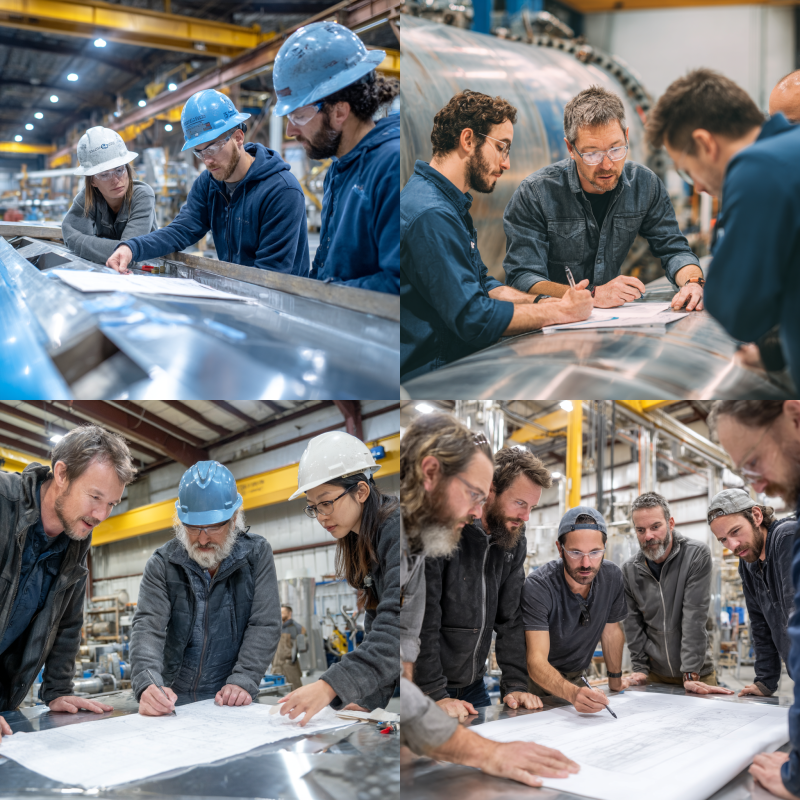
What Materials Are Used in Pressure Vessel Fabrication?
A Detailed Look at What Materials Are Used in Pressure Vessel Fabrication
If you are looking into what materials are used in pressure vessel fabrication, you already know that selecting the right substance can determine the vessel’s durability, safety, and overall performance. Different metals and composites bring different strengths, so a thoughtful approach to materials can help you cut risks, save maintenance costs, and achieve reliable results.
Beyond strength and durability, the material you choose also affects fabrication, maintenance, and compliance with industry standards. Some metals are easier to weld and shape, while others offer superior resistance to corrosion or harsh chemicals. Choosing the right material ensures your pressure vessel performs reliably, lasts longer, and meets the safety and regulatory requirements of your industry.
What materials are used in pressure vessel fabrication
Many vessels rely on various grades of steel, but the exact choice—such as stainless steel, carbon steel, or even exotic alloys depends on a few key factors (pressure range, temperature limits, and potential corrosion). For instance:
- Carbon steel: Often used in standard applications with moderate pressure and temperature requirements. Its affordability makes it a common go-to material.
- Stainless steel: Suitable where corrosion resistance is crucial. Industries like biotech or food processing often choose stainless steels (such as 304, 316) for their cleanability and durability. If you want more details on cost and design, you can check out stainless steel pressure vessel manufacturers.
- High-strength alloy steels (like chrome-moly): Built for higher temperature or pressure service. They withstand harsh conditions and can maintain integrity for long periods.
- Composites or exotic metals: Specialized scenarios may call for titanium, Inconel, or advanced polymers. These materials are lighter or more corrosion-resistant but can be pricier and may require specialized expertise.
One leading supplier of ASME pressure vessels, Red River, routinely explores new and composite materials to stay at the forefront of fabrication techniques (Red River Team). Good news this evolution in materials means you can often find a perfect match for nearly any environment or process.
Choosing the right metal or composite
Selecting the right base material starts with analyzing your operating environment. For example, if your process carries corrosive chemicals or experiences repeated temperature shifts, stainless steel or high-strength alloys might be best. You will also want to consider:
- Pressure ratings: The vessel must hold up under continuous internal pressure without risk of cracks or leaks.
- Temperature ranges: Elevated operating temperatures can weaken some steels, so high-temp alloys are key.
- Corrosion concerns: If you handle acidic or caustic substances, stainless steels, composites, or special linings are crucial.
- Cost considerations: While exotic metals cost more, they can pay off in extended service life and fewer repairs.
To learn more about overall fabrication steps, try exploring what is pressure vessel fabrication. It can help you see how your materials choice fits into the broader manufacturing process.
Why specialized welding and testing matter
Even the best metal can fail if the welding or inspection is sloppy. An ASME pressure vessel manufacturer follows codes that ensure safe designs, but that is just the start.
- Qualified welding procedures: Industry leaders use advanced methods to join carbon, stainless, and more unique alloys. Red River, for instance, has a world-class quality control process featuring full traceability and rigorous testing (Red River Solutions).
- Non-destructive examination (NDE): Techniques like X-ray or ultrasonic testing verify weld integrity without harming the vessel.
- Hydrostatic and leak testing: Finished vessels face pressure checks to confirm they can handle in-field stress.
If you are comparing options, look for asme pressure vessel manufacturers who meet these inspection standards. Though it might raise upfront costs, specialized welding and testing save you money (and stress) down the line.
Key Insights on What Materials Are Used in Pressure Vessel Fabrication
Understanding what materials are used in pressure vessel fabrication is essential to building a reliable and cost-effective system. Here’s a recap:
- Carbon steel is great for general, low-risk use.
- Stainless steel excels in corrosive or hygienic environments.
- Alloy steels resist high heat and pressure over time.
- Exotic materials and composites provide niche benefits where nothing else will work.
But no matter the material, proper welding, inspection, and quality control are just as important. Partnering with a trusted, certified manufacturer ensures your vessel meets the highest standards in safety and performance.
Ready to Choose the Right Materials for Your Next Pressure Vessel?
Don’t risk failure with the wrong build. Contact Red River today to discuss what materials are used in pressure vessel fabrication and how to match them to your project’s needs. Let’s build something reliable together!
Frequently Asked Questions
1. What is the biggest factor when choosing a pressure vessel material?
Pressure demands are usually first. Next come temperature range, corrosion risk, and budget constraints.
2. What is pressure vessel fabrication?
Pressure vessel fabrication is the process of designing, manufacturing, and assembling vessels that can safely hold gases or liquids at high pressures. It involves precision engineering, quality material selection, and adherence to safety standards to ensure durability and reliability.
3. How are pressure vessels fabricated?
Pressure vessels are fabricated through a series of steps including material selection, cutting, forming, welding, heat treatment, and inspection. Skilled technicians ensure each component meets design specifications and regulatory safety standards before the vessel is assembled and tested.
4. What materials are used in pressure vessel fabrication?
Common materials include carbon steel, stainless steel, and sometimes composite materials. The choice depends on the intended use, pressure level, temperature, and potential for corrosion. High-quality materials help ensure the vessel’s strength, longevity, and safety.
5. What measures ensure pressure vessel safety?
Ensuring pressure vessel safety is critical to prevent leaks, ruptures, or catastrophic failure. Proper design, material selection, and adherence to inspection protocols are essential. Techniques like non-destructive testing (NDE), hydrostatic testing, and traceable material certification help maintain compliance and long-term safety.
6. Why should I choose ASME pressure vessel manufacturers?
Choosing an ASME-certified pressure vessel manufacturer ensures your vessel meets strict design, welding, and inspection standards. These manufacturers follow the ASME code, guaranteeing quality, durability, and regulatory compliance, which reduces risk and increases reliability.
Key takeaways
- Carbon steel suits most basic pressure vessel applications at moderate cost.
- Stainless steel resists corrosion, which is ideal for hygienic or harsh environments.
- High-strength alloy steels handle repeated high pressures and elevated temperatures.
- Composites reduce weight and resist certain chemicals, but they can be more complex to fabricate.
- In-house testing, like X-ray and hydrostatic checks, ensures a pressure vessel meets safety standards.
